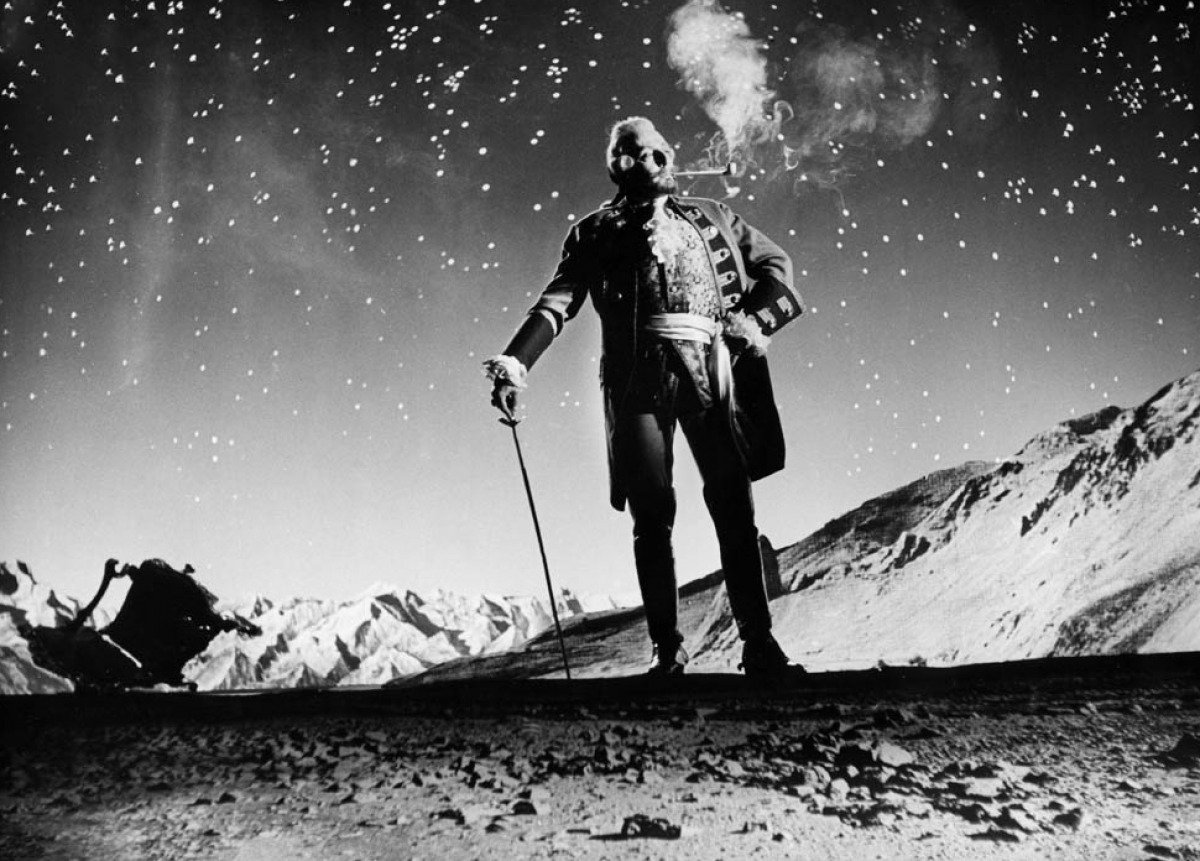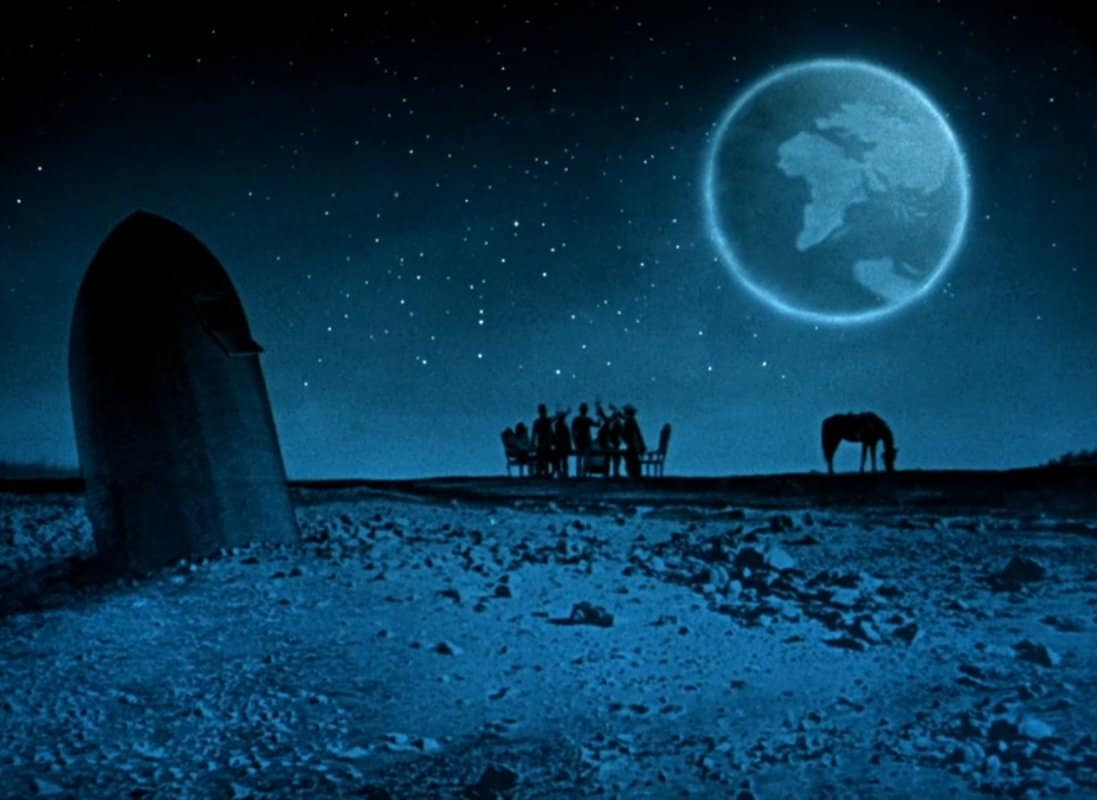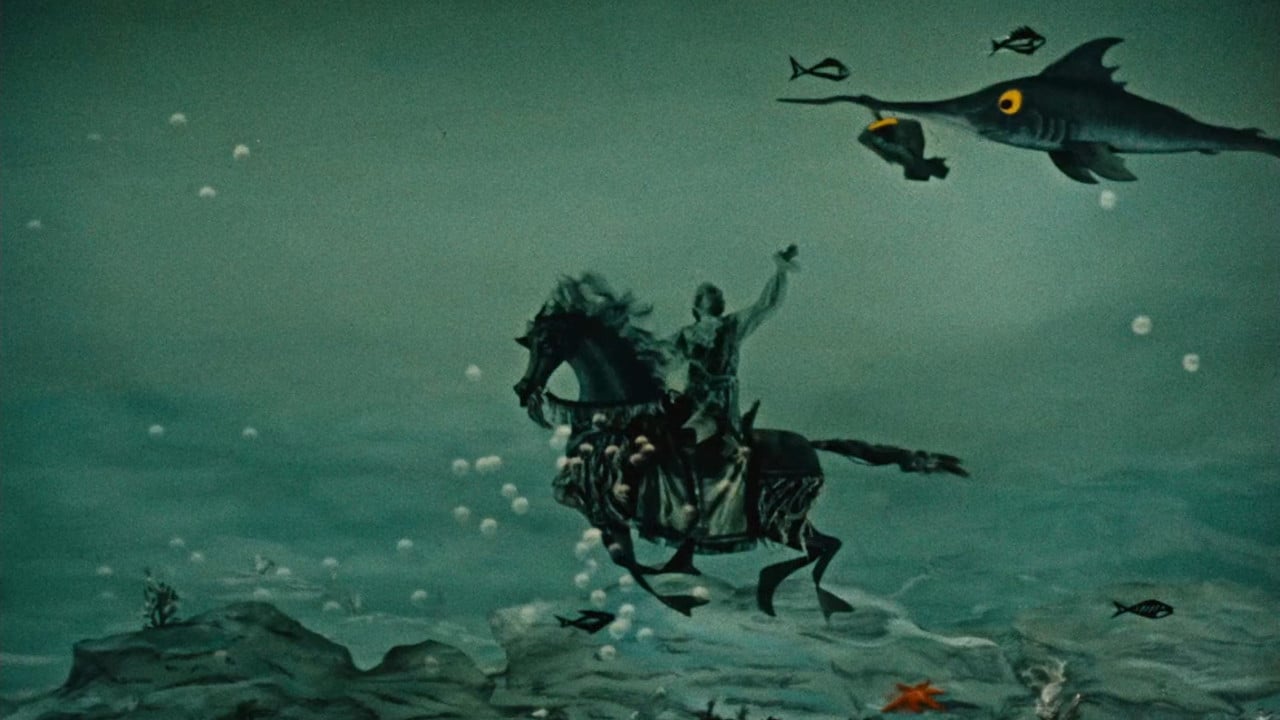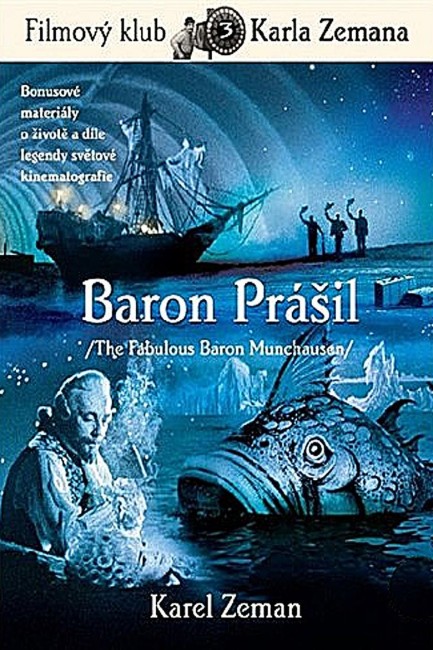aka The Fabulous Baron Munchausen
(Baron Prasil)
Czechoslovakia. 1962.
Crew
Director/Screenplay/Artist – Karel Zeman, Dialogue – Josef Kainar, Producer – Josef Ouzky, Photography (colour + b&w and tinted) – Jiri Tarantik, Music – Zdenek Liska, Animation – Arnost Kupcik, Frantisek Krcmar & Jindrich Liska, Production Design – Zdenek Rozkopal. Production Company – Kratky Film/Filmove Studio Gottwaldov.
Cast
Milos Kopecky (Baron Munchausen/Baron Prasil), Rudolf Jelinek (Tonik/Tony), Jana Brejchova (Princess Bianca), Jan Werich (Ship’s Captain), Karel Hoger (Cyrano de Bergerac), Eduard Kohout (General Pellmell), Rudolf Hrusinsky (The Sultan)
Plot
The astronaut Tony lands on The Moon to be greeted by the voyagers of the imagination that have travelled there before him – Cyrano de Bergerac, Baron Munchausen and Jules Verne’s explorers. Believing Tony to be a Lunarian, Baron Munchausen decides to take him on a tour of the Earth he knows. Flying down by bird-drawn gondola, they land in Turkey and seek an audience before the Sultan. The Princess Bianca implores Tony to rescue her from the palace. They are pursued by the Sultan’s navy, which the Baron despatches by raising a thick cloud of tobacco smoke around their ship, causing the Turkish ships to shoot and sink each other in the fog. Next, the Baron and the princess are swallowed by a whale. Joining the various other crews trapped in the stomach, the Baron decides to use the whale’s journey around the world as an opportunity to woo the princess away from Tony. Emerging, they take refuge at a fort that is under siege from attacking armies. The Baron takes a trip across the battlefield on a cannonball to survey the whereabouts of the opposing armies. However, when Tony leaves them defenceless after appropriating all of the gunpowder from the cannons to turn the fort into a rocket so he can take the princess to The Moon, this has him sentenced to execution.
Czech filmmaker Karel Zeman (1910-89) is one of the great, largely unrecognised names in genre cinema. Starting out as an animator, Zeman made his directorial debut with the animated A Treasure of Bird Island (1953) and then the live-action Journey to the Beginning of Time (1955). It was his next film The Fabulous World of Jules Verne (1958), also known under a host of alternate titles, that caught public attention, coming right in the midst of and being able to take advantage of a Hollywood fad for period Jules Verne adaptations in the late 1950s.
Zeman’s films are amazing works, combining live-action, animation and cutouts in such ways that we are frequently never sure what is what. Even more appealing is the nonchalant absurdism of Zeman’s visuals, which are of an imaginative league that few other directors have achieved. Zeman went onto a host of other films in a similar vein with the likes of A Jester’s Tale/War of Fools (1964), The Stolen Airship (1967), On the Comet (1970), Tales of 1001 Nights/The Adventures of Sinbad the Sailor (1974), The Sorcerer’s Apprentice (1978) and The Tale of John and Mary (1980)..
Flush from the international success of The Fabulous World of Jules Verne, Karel Zeman next turned his attentions to the story of Baron Munchausen. (Both Jules Verne and Baron Munchausen had been adapted into films/served as sources of inspiration to Georges Melies whose style of filmmaking heavily influenced Zeman). Baron Munchausen, or to use him his real name, Karl Friederich Hieronymous Von Munchausen (1720-97), was an actual historic figure. Born in Bodenwerder, Germany, Munchausen fought in the Russian army in several campaigns against the Turks. In the officer’s mess, he began to concoct wilfully fanciful accounts of his exploits. These were later collected by his friend Rudolf Erich Raspe and published in English as Baron Munchausen’s Narrative of His Marvellous Travels and Campaigns in Russia (1795), something that Munchausen was never pleased with, even though the book proved immensely popular.

Into the 20th Century, the material has proven lucrative to filmmakers – Georges Melies made his version The Adventures of Baron Munchausen (1911); there was a lost British version in 1927; Münchhausen (1943), an opulent colour production produced in Germany under the Nazis; The Fabulous Adventures of Baron Munchausen (1977), a French-made animated children’s film; most famously Terry Gilliam’s The Adventures of Baron Munchausen (1989) starring John Neville; and Baron Münchhausen (2012), a German tv mini-series.
Of these, Karel Zeman’s Baron Munchausen (who is referred to as Baron Prasil in the Czech language, although is the same character as Baron Munchausen in every other regard) is regarded as the best film version of the Baron’s exploits by those who have seen it. (Reportedly, Terry Gilliam was inspired to conduct his remake after seeing a print of the Zeman film). Although it did receive an international release in 1964, the film does not have a high profile in English-speaking countries.
Karel Zeman takes the same fabulist approach he did in The Fabulous World of Jules Verne, basing the visual look of the film on the lithographs of celebrated 19th Century illustrator Gustave Doré (as well as those for the German translation of the Baron’s adventures by Gottfried August Bürger). Whereas The Fabulous World of Jules Verne was in black-and-white, the major difference here is the addition of colour, as well as black-and-white scenes that are tinted different colours (just as Melies used to do).

Zeman creates a wraparound framework to the telling of the story, transplanting the Baron’s adventures into the present-day of the 1960s Space Age where an astronaut arrives on the Moon to be greeted by Munchausen and early fabulist travellers such as Cyrano de Bergerac and Victor Barbicane from Jules Verne’s From the Earth to the Moon (1865) whereupon Munchausen mistakes the astronaut for a Lunarian and determines to take him on a tour of ‘his world’. The idea is to contrast the two as imagineers, where the Baron is constantly taking the astronaut’s engineering marvels and recounts of the modern world as rival works of fancy.
What is visually alluring about the film is the same thing that we saw in The Fabulous World of Jules Verne – Zeman’s employment of the amazing mix of animation, cut-outs and live-action. There are wonderfully appealing shots – like the Sultan with his retreating throne, which is replaced by a giant cannon before Zeman cuts away to an animated diagrammatic cutout that shows a giant contraption of clockwork and mechanical parts beneath the throne room.
Zeman has a perfect sense of nonsensical fabulism, which makes him ideal for adapting the Baron Munchausen tales. The venture into the sultan’s palace to rescue the princess is full of charming images – the Baron’s hand sneaking up to makes moves in a chess game being played by two guards; swordfights conducted to jaunty xylophone music; the Baron emerging from a fight with the bodies of 10,000 guards lying with their feet all neatly lined up; the Baron and Tony (Rudolf Jelinek) struggling to batter down a seemingly locked door before the princess (Jana Brejchova) calmly walks over and opens its sliding panels.

The most charming sequence is where the Baron falls underwater on his horse and then calmly swims along on horseback, taking back his coat as a swordfish swims by with it draped from its nose, passes through a giant fish’s mouth and then out another mouth at the other end, encounters mermaids and shoos off sharks. Other highlights include the Baron’s journey into the whale (where he uses the opportunity of a trip around the world to woo the Princess) and the flight across the battlefield by cannonball to scout the enemy’s position (and then returning from whence he came by simply jumping onto a cannonball fired in the other direction). There is a wonderfully eccentric menagerie of creatures that turn up throughout the film – cartoonish sea monsters, giant spiders and the perfectly nonchalant image of the Baron sitting back to smoke his pipe as he is carried away in the claws of a dragon creature.
For all its being made with primitive resources that were way before the era of CGI and motion control cameras, Baron Munchausen has an almost unlimited degree of imagination and visual playfulness that seems completely lacking in most modern $100+ million dollar films. Baron Munchausen is slightly the lesser of The Fabulous World of Jules Verne but never any more the enjoyable for all that.
Trailer here


